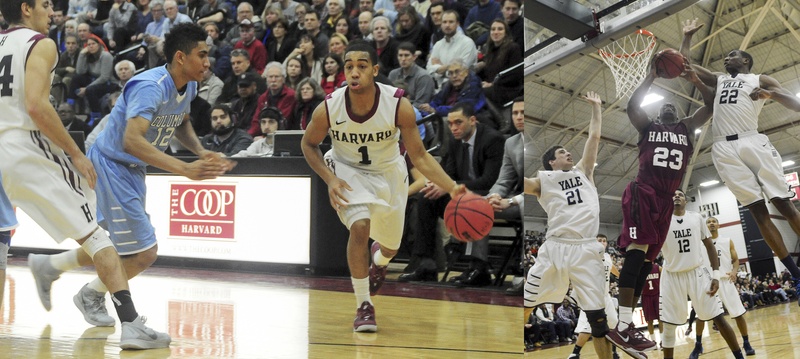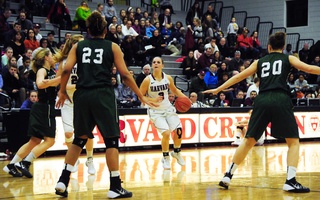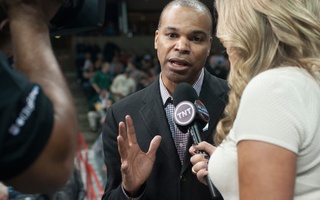
Shown left, Columbia junior Maodo Lo is a leading candidate for Ivy League Player of the Year. His competition? Yale junior Justin Sears and Harvard senior Wesley Saunders, shown right
Leading up to Friday night's conference-deciding Harvard-Yale tilt in Cambridge (8 p.m., ASN), the Ivy League Player of the Year race is still up in the air. Below, three Crimson sportswriters pitched their choice for ILPoY.
Justin Sears:
By Julian Ryan
To understand why Justin Sears is the best player in the Ivy League this year, you have to embrace the importance of the less glamorous side of the sport of basketball: defence and efficiency. Sears is a skilled and athletic wing who has absolutely been putting up buckets, but what ultimately separates him from the competition this season is combining that with a truly excellent defensive season and canny shooting season. Sears is the reason he’ll be leading his team into Lavietes this weekend with a chance to usurp the Crimson dynasty.
My fellow columnists may throw Hollinger’s Player Efficiency Rating, Myers’ version of Statistical Plus-Minus or Kubatko’s Win Shares out there as all-in-one ‘holy grail’ statistics which may argue why Sears is not the justified winner, but these metrics are flawed for this occasion. Firstly, at their core they are simple weightings of the box-score stats, the things we can count like points, assists and steals, and those weightings are based off NBA-based analyses. Although the formulas can be computed for college players, they do not necessarily reflect the college game, particularly when we get to the extremes as with these players. Secondly and more crucially, adjusting for strength of schedule is far more important in college, given there is significantly more variation in quality than the NBA. By kenpom.com, Columbia faced a considerably non-conference easier schedule than Harvard and Yale (who had the hardest of the three) and it is extremely difficult to appropriately adjust for that. So in my argument, I’m only going to rely on conference game data – even though admittedly Saunders has actually regressed a bit since his manic start to the season. The following statistics are all from college basketball reference from Ivy League play this season:
|
|
Wesley Saunders |
Maodo Lo |
Justin Sears |
|
Points per Game |
16.8 |
18.1 |
16.8 |
|
Rebounds per Game |
6.8 |
4.3 |
8.1 |
|
Assists per Game |
4.5 |
2.4 |
1.9 |
|
Steals per Game |
1.5 |
1.2 |
1.2 |
|
Blocks per Game |
0.3 |
0.2 |
2.4 |
|
Offensive Rating |
112.7 |
114.9 |
121.5 |
|
Defensive Rating |
91.6 |
106.4 |
89.9 |
|
Usage Rate |
31.5 |
29.9 |
25.7 |
In these three numbers, Sears’ argument becomes clear. He has used significantly fewer possession than his teammates and according to this research, Saunders and Lo have actually been probably about as efficient as Sears this season after adjusting for their drop in efficiency from taking so many more shots for their team. However, that is clearly a conscious choice by Sears, who was scoring almost 20 points per Ivy game last season, but this year has curtailed that for an efficient attack. This is only logical when the also very efficient Javier Duren (ORtg 108.5 in Ivy play) is in the backcourt. Neither Lo nor Saunders can claim to have a teammate with the same level of offensive firepower of Duren this season (poor one out for Siyani Chambers). The per-game stats are up there to show you that all these guys contribute heavily to their team, with Saunders’ assists and Sears’ rebounds and blocks jumping out as impressive. The big three though are at the bottom. Offensive and Defensive Ratings were invented by Dean Oliver in ‘Basketball on Paper’ and, from a theoretical framework so crucially it can be applied to college hoops, devised a system by which the weights he placed on box-score stats changed depending on their interaction and on team characteristics in general. He discerned that the value of an assist to a high percentage shooting team was worth more than to a team that shot poorly, and so allowed his weights to vary accordingly. The numbers should be viewed as an estimate of how many points the player is responsible for producing (on offense) or allowing (on defense) per 100 possessions. Usage Rate is how often a team’s possession ends with a shot, trip to the line or turnover by that player when he is on the court.
Defensively though, Sears is by himself. To interpret defensive rating numbers, one must appreciate that team defence plays a large role in the calculation, as defensive statistics make up a small part of the box-score. While Saunders has played on a ferocious Harvard defence, with multiple plus-defenders on the court at any one time and ranked top 25 in the nation by kenpom.com, Yale’s defence has been good but hardly great. When taking this into account, Sears’ defensive rating is substantially better than Saunders’, even though they look similar in a vacuum.
Lo’s inability to bring it on defence sees him out of the competition. Saunders is undeniably impressive in shouldering such a heavy load for his squad. But in combining efficient shooting with absolutely elite defence, Justin Sears is the only logical winner of Ivy League Player of the Year.
Wesley Saunders:
By David Freed
Entering Saturday night’s titanic contest between Harvard and Yale, the race for Ivy League Player of the Year looks to be a three-way contest between senior wing Wesley Saunders, Yale junior forward Justin Sears, and Columbia junior Maodo Lo. My fellow columnists have argued in favor of Sears and Lo, but combining tactical and statistical analysis, it is obvious Saunders is the champion.
Lo has the weakest candidacy of the three. The strongest argument is that he’s the most effective (and proficient) scorer in the Ivy League, recently dropping 35 points on Brown and 33 on Harvard, shooting a combined 66 percent in those two games. On the less glamorous parts of the games, Lo struggles. His defensive rating of 106.4 in Ivy League play is by far the worst of the candidates and he has been a ball-stopped by point guard standards, averaging just 2.4 assists a game in Ivy League play
Looking at Sears and Saunders, it’s a question of value. Both teams structure their schemes around their star’s unique talents—Yale’s defense is based on funneling all ball-handlers to Sears inside; Harvard relies on Saunders to check the opponent’s best perimeter player and he’s spent time on point guards and power forwards alike at various parts of the year.
The statistics are kinder to Sears, who boasts a lead in Win Shares (2.6 to 2.2), defensive rating (90.1 to 91.6), and true shooting percentage (60.4 percent to 52.9 percent). The largest reason for the differences is shooting efficiency. Given that Harvard’s late-clock strategy is a typical variant of “give the ball to Wes and pray,” a bulk of Saunders’ shot selection is contested jumpers in the lane everyone on the defense is waiting for.
The lack of offensive weaponry around him is evident in the decline in his true shooting and effective field goal percentage. Sophomore year, when coach Tommy Amaker spaced the floor around him with three shooters, Saunders had significantly more room to operate and got to the free throw line much more—shooting a higher percentage at the rim. Sears has many of these same advantages, routinely playing with two or more ace three-point shooters behind him. Harvard, by contrast, often looks like it is playing four-on-five on offense, with defenders hardly guarding junior Agunwa Okolie to key in on Saunders.
Given this, we can look elsewhere to properly evaluate the two men’s games. Looking at the numbers, the first thing that jumps out is that both players boast roughly the same total rebounding percentage—indicating that from the wing, Saunders is giving his team forward-level rebounding. On a playmaking level, there is similarly no comparison—Saunders’ assist percentage (35.5 percent) is nearly three times Sears’ (13.9) while managing a lower turnover percentage. He has been responsible—through score or assist—for nearly 40 percent of the Crimson’s offense this season, something Sears cannot boast.
Read more in Sports
Men's Basketball Loses Control of Ivy Fate With Loss to YaleRecommended Articles
-
Barrett Was No Harvard RadicalWhen gubernatorial candidate and State Senator Michael J. Barrett '70 attended Harvard, a wave of civil rights and anti-war protests
-
 Women's Basketball: Around The Ivies
Women's Basketball: Around The Ivies -
 Men's Basketball: Around The Ivies
Men's Basketball: Around The Ivies -
Football Takes Home Postseason AwardsIn the aftermath of a last-minute win over Yale in the 131st playing of the Game, several Crimson players earned more than the emotional satisfaction of a thrilling finish—they also racked up personal honors.
-
 Cornell, Columbia To Test Men's Basketball in Last Ivy Road Weekend
Cornell, Columbia To Test Men's Basketball in Last Ivy Road Weekend -
NOTEBOOK: Men's Basketball Rebounds Against ColumbiaOn a night where tipoff was delayed 15 minutes by Columbia’s Senior Day ceremonies, it was Harvard’s original class of 2015 that shined strongest.













